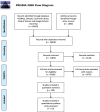The efficacy and safety of fast track surgery (FTS) in patients after hip fracture surgery: a meta-analysis
- PMID: 33639957
- PMCID: PMC7913454
- DOI: 10.1186/s13018-021-02277-w
The efficacy and safety of fast track surgery (FTS) in patients after hip fracture surgery: a meta-analysis
Abstract
Background: Fast track surgery (FTS) has been gradually applied in perioperative management of orthopedic surgery, but there still some research suspected that the prognosis of patients is not as expected and the cost is high, the effect of the FTS still urgently needed for support by evidence-based medicine.
Methods: We retrieved RCTs from medical research literature databases. Risk ratios (RR), standard mean difference (SMD), and 95% confidence intervals (CI) were calculated to compare the primary and safety endpoints.
Results: Overall, a total of 8886 patients were retrieved from 57 articles, of which 4448 patients (50.06%) were randomized to experimental group whereas 4438 patients (49.94%) were randomized to control group. The result showed that FTS could significantly shorten the length of stay (LOS), decrease the visual analog scale (VAS), reduce the leaving bed time and the hospitalization costs, and improve Harris hip joint function score. The incidence of complications such as respiratory system infection, urinary system infection, venous thrombus embolism (VTE), pressure sore, incision infection, constipation, and prosthesis dislocation also has been decreased significantly. Meanwhile, FTS improved patients' satisfaction apparently.
Conclusions: This meta-analysis reveals that FTS could significantly shorten the length of stay, alleviate the pain, reduce the leaving bed time and the hospitalization costs, and improve hip function. The incidence of complications also has been decreased significantly. Meanwhile, FTS has been spoken highly in patients in terms of nursing satisfaction. Its efficacy and safety were proved to be reliable.
Keywords: Enhanced recovery after surgery (ERAS); Fast track surgery (FTS); Hip replacement; Meta-analysis.
Conflict of interest statement
The authors declare that they have no competing interests.
Figures
















References
-
- Greenlee WE. Hip prosthesis and the use thereof. 2006.
-
- Bureau MN, Legoux JG, Denault J. Implantable biomimetic prosthetic bone. 2009.
-
- Jiang ZW, Li JT. The present situation and prospect of accelerated rehabilitation surgery. (In Chinese) Chin J Surg. 2016;54(1):6–8. - PubMed
Publication types
MeSH terms
Grants and funding
LinkOut - more resources
Full Text Sources
Other Literature Sources
Medical

